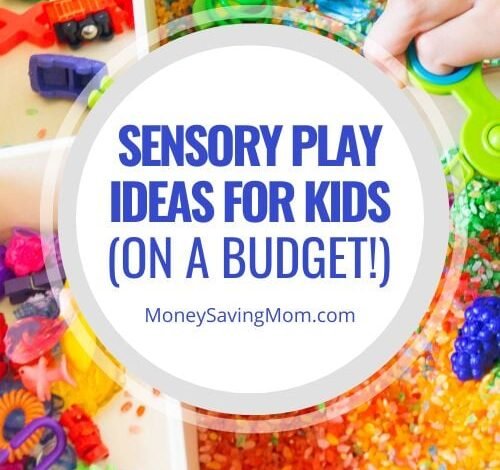
If you have younger kids and you’re looking for ways to incorporate sensory play on a budget, this post is filled with all kinds of amazing ideas and tips!
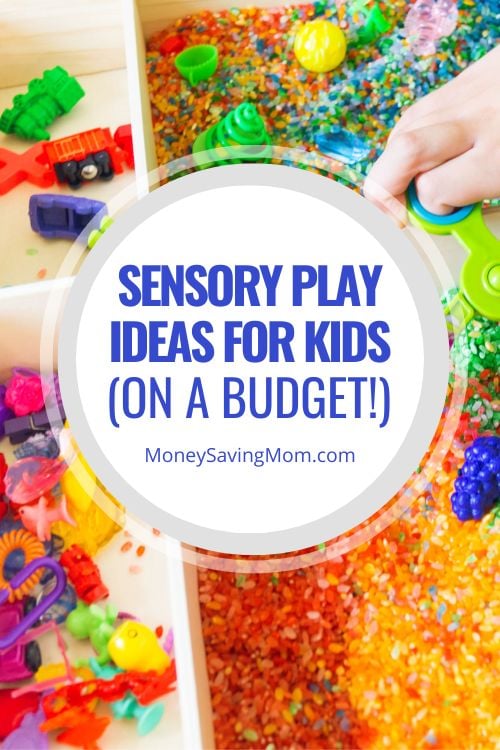
The following is a guest post by Lisa Marie George:
As a preschool director, I’ve seen firsthand how crucial play is in the early years of childhood development, especially when it involves engaging the senses.
Sensory play, especially, is a vital part of how young children learn about the world. It helps boost creativity, sharpens motor skills, and supports sensory integration — all through the joy of play.
Fortunately, setting up a sensory play area doesn’t mean you need to spend a fortune or have a specialized space. With some imagination and a few household items, you can create a wonderful sensory playground right in the comfort of your own home.
Whether you’re crunching leaves underfoot, squishing colorful dough, or exploring the scents of a spice rack, every moment of sensory play is a building block for your child’s future.
Let’s get started on creating that special space where little hands and minds can explore, discover, and grow!

Understanding Sensory Play
What exactly is sensory play? At its core, sensory play is any activity that stimulates a child’s senses: touch, smell, hearing, sight, and taste. Children learn to understand the world around them by engaging their senses through exploration, experimentation, and of course, play.
Handling gooey slime, listening to the chime of metal spoons, smelling fresh herbs, gazing at swirling colors, or tasting a variety of new foods — these experiences aren’t just enjoyable, they’re central to how children take in, analyze, respond to, and ultimately learn from processing sensory information.
Sensory play is actually critical to children’s cognitive growth (source), particularly in areas like language development, numerical understanding, and problem-solving.
What’s even more exciting is that engaging multiple senses simultaneously during play doesn’t just amplify the fun; it cements learning experiences more deeply.
For instance, a child who learns about the concept of ‘orange’ by touching a smooth, cold orange, smelling its zest, and tasting its tangy juice, will likely remember the experience more vividly than if they were just to see a picture of an orange on a flashcard.
By incorporating activities that touch on all these sensory aspects, we provide a rich tapestry of experiences that help children form connections and enhance their ability to retain complex concepts.
Let’s explore how simple, everyday items can become tools for sensory discovery, fostering not just education but also a lifelong love of learning.

Setting Up Your Space
Choosing the right spot for a sensory play area in your home can be as simple as looking for spaces that are both safe and easy to clean!
Ideally, this means areas with washable surfaces or floors, like tile or hardwood, which can quickly be wiped down after a session of messy play. (If you’re working with carpet, no worries — a large, wipeable mat or tarp can be a game changer.)
Now, about furnishing the space — flexibility is key. Choose multi-purpose furniture that does double duty and can easily be moved or stored away.
Think lightweight, durable tables that are just the right height for your little ones, and can be tucked away when not in use. Storage ottomans are perfect for this, as they provide both a seating option and a place to stash toys and materials when playtime is over.
Remember, your child’s interests and abilities will evolve, and so should their play space. This doesn’t mean a constant overhaul but rather choosing elements that can be easily adapted.
Adjustable shelves, bins with removable dividers, and curtains that can segment or open up spaces are all excellent choices. These adapt as your child grows — from a toddler who loves crashing blocks to a preschooler who’s fascinated by fine motor skill crafts.
Creating a sensory space that can grow with your child not only makes sense logistically but also ensures a continually stimulating environment that keeps pace with their developmental milestones.
Now, let’s dive into how you can stock this space with materials that are both engaging and easy on the wallet.
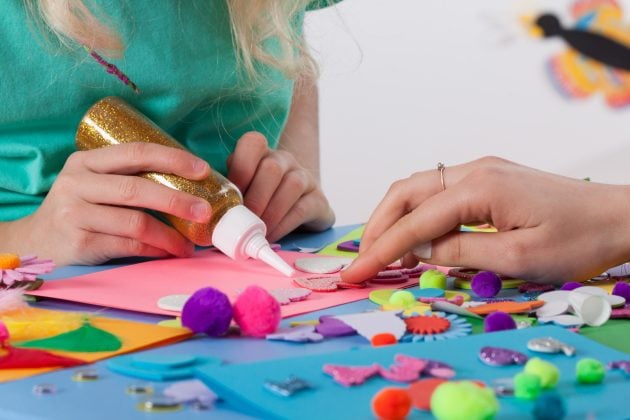
Budget-Friendly Materials and Tools
Creating an engaging sensory play area doesn’t have to strain your budget. You likely already have many of the materials you need at home, and they’re just waiting to be repurposed! Let’s start with the basics:
- Containers of all sizes: From empty yogurt cups to large storage bins, containers can be used for sorting activities or as vessels for sensory bins filled with rice, beans, or water.
- Fabrics and textiles: Gather various textures like velvet, satin, or denim. These can be used in a touch-and-feel board or simply as objects to explore in a sensory bin.
- Sponges, brushes, and scrubbers: These everyday items offer a range of textures and are great for sensory exploration, especially when combined with water play.
Using the materials you gathered, the sky’s the limit on how many DIY sensory projects you can create. For some ideas that are both fun and educational, try:
- DIY Sensory Bins: Use large plastic bins to create themed sensory experiences. Fill the bins with items like dried beans, rice colored with food dye, sand, or soapy water. Add scoops, small cups, and/or toy figures for hours of imaginative play.
- Homemade Tactile Boards: Attach items with different textures onto a large board or a sturdy piece of cardboard. Include items like zippers, buttons, and ribbons to enhance fine motor skills and sensory exploration.
- Nature Exploration Kits: Collect natural items like stones, pinecones, and leaves. Place them in a bin along with shatterproof magnifying glasses to encourage detailed observation.
If you need additional materials, consider these inexpensive and sustainable sources:
- Thrift Stores: You can find a treasure trove of materials such as baskets, trays, fabric scraps, and kitchen gadgets—all perfect for sensory play.
- Online Marketplaces: Websites like Craigslist or Facebook Marketplace often have listings for free or very cheap items that are ideal for sensory play, such as old furniture for a sensory board, or bulk materials like sand or gravel.
By looking around your home and visiting a few budget-friendly stores, you can easily amass a wealth of materials that will enrich your child’s sensory play without breaking the bank.
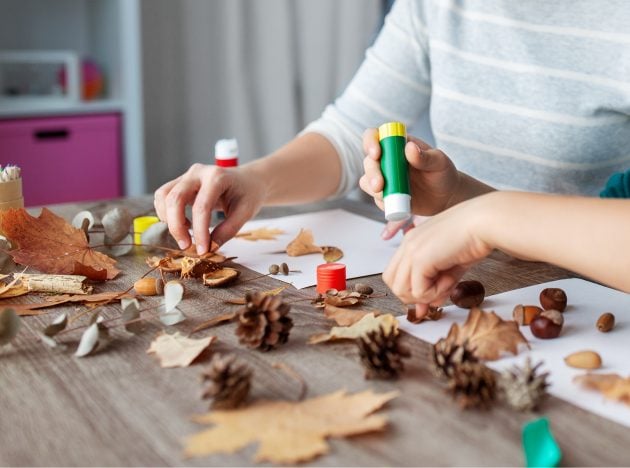
Sensory Activities for Each Sense
Creating activities that cater to each of the five senses can provide a holistic sensory experience for your child. Here are some simple and safe ideas that you can implement at home:
Touch
- Homemade Play Dough: Mix 2 cups of flour, 1/2 cup of salt, 2 tablespoons of cream of tartar, 2 tablespoons of vegetable oil, and 1 1/2 cups of boiling water. Add food coloring for a visual pop. This dough is perfect for squeezing, pounding, and sculpting.
- Homemade Flubber: Click through for instructions on how to make your very own batch of flubber with ingredients you’re sure to already have around the house. It’s sensory fun at its finest.
- Texture Boards: Attach different materials such as felt, sandpaper, and bubble wrap to a board. Allow your little one to explore and compare textures.
Sound
- Shakers: Fill empty containers with beans, rice, or beads. Secure the lids tightly with tape for safety.
- Drums: Use pots, pans, and plastic containers paired with wooden spoons or chopsticks as drumsticks.
Smell
- Scent Jars: Fill small jars with various aromatic materials like coffee beans, cinnamon sticks, or vanilla pods. Ensure they’re securely closed to prevent spills.
- Sensory Bottles: Mix water with essential oils (like lavender or mint) and add items like flower petals or citrus rinds to enhance the scent.
Sight
- Color Exploration Area: Set up zones with items of the same color Include toys, fabrics, and papers to explore shades and hues.
- Shadow Play: Use a flashlight to cast shadows of different shapes and objects onto a wall or a white sheet. Children can experiment with moving the objects closer to or farther from the light source to see how the size and shape of the shadows change.
Taste
- Taste Test Games: Offer a variety of foods in small portions — slices of fruit, small cubes of cheese, and crackers all work well. Engage your child in talking about the flavors and textures they experience.
Each of these activities is designed to be safe, fun, and highly engaging, ensuring that learning is always at the heart of play.
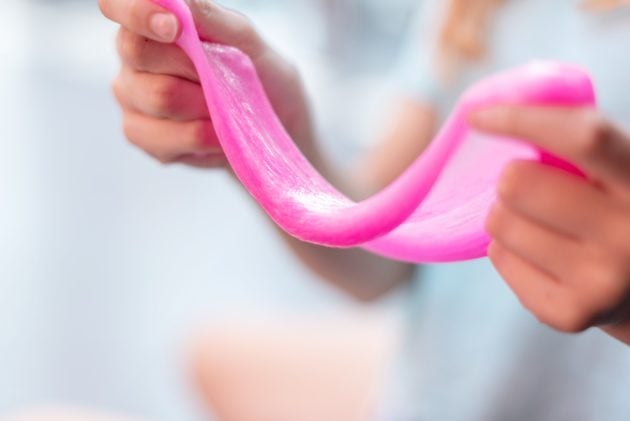
The Lasting Impact of Sensory Play
Creating a sensory play space at home offers is a fantastic way to support your child’s development. It supports creativity, enhances motor skills, and aids in sensory integration — all through the joy of play.
By providing a safe and engaging environment where your little ones can touch, taste, see, smell, and hear, you’re laying the foundation for a love of learning that will extend far beyond these early years.
Take joy in small moments of discovery and learning you cultivate. Encourage exploration and be sure to let your child lead the way in their sensory adventures. Each sensory experience is a stepping stone to a future where your child is not only equipped to handle the world’s complexities but is also capable of appreciating its vast beauty.
Embrace the mess, relish the chaos, and celebrate each little learning milestone with your child. It’s all part of the incredible journey of growing up!
Lisa Marie George is the owner and director of The Anne Brower School in Huntington, NY, where children explore and grow in an enriched, creative, and joyful learning environment. At school, Lisa Marie channels over a decade of experience into instilling a lifelong love of learning in each and every one of her school’s students. At home, Lisa Marie is a mother to three wonderful children, from whom she gains new insights every day. Their curiosity and fresh perspectives continually enrich her understanding and approach to both parenting and early childhood education.
Source link



